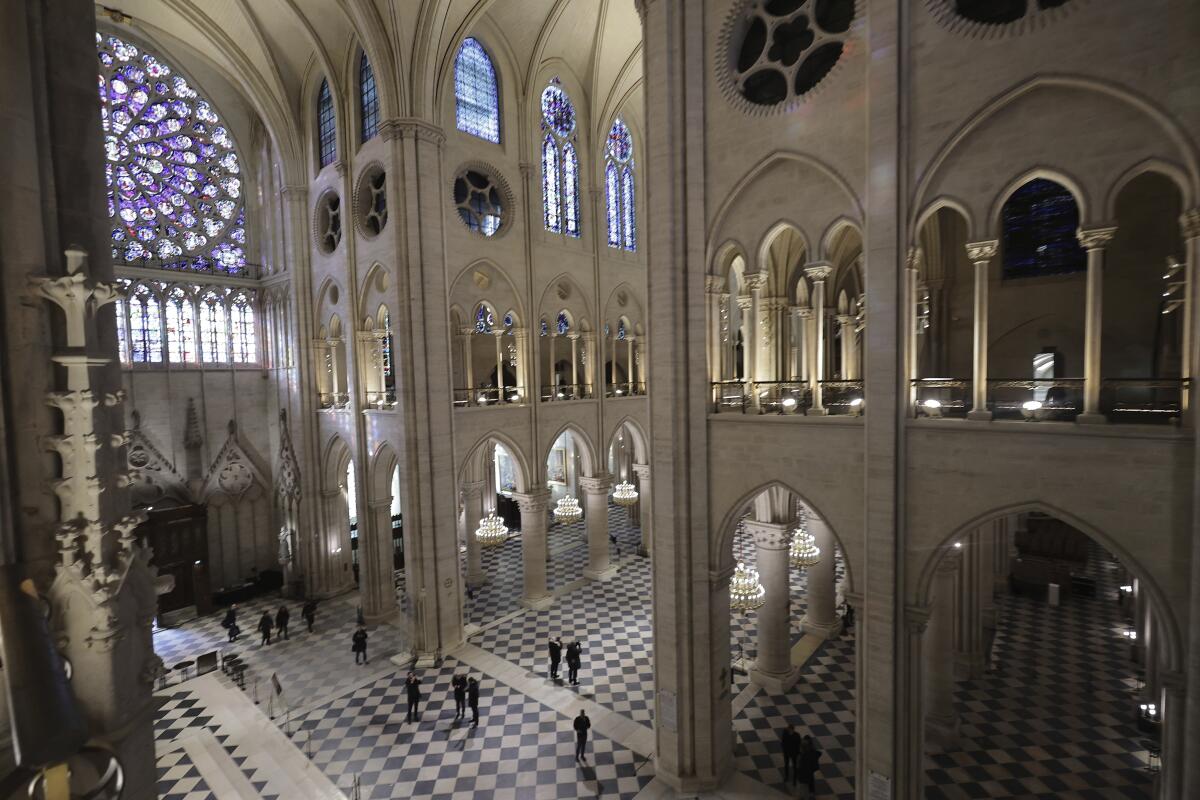PARIS — The day after the inferno struck Notre Dame on April 15, 2019, Philippe Villeneuve walked despondently into the remains of his cathedral.
Smoke choked the spring air, the spire lay in rubble, and charred beams littered the nave. “We had lost the framework, the roof, the spire, and three sections of the vault,” said Villeneuve, its chief architect since 2013.
Yet just hours earlier, French President Emmanuel Macron had issued an extraordinary decree: Notre Dame would rise again — in just five years. There was one big problem, Villeneuve said in an interview — “the deadline.”
It felt impossible. Yet as Villeneuve stepped through the wreckage, he was caught by surprise. Terrifying as it was to see the charred remains of the 861-year-old Gothic treasure, hope emerged.
“All the stained-glass windows were spared, the great organ, the furniture, the paintings — everything was intact,” he said. “It was doable.”
A historic restoration
Macron’s decree became the driving force behind the most ambitious restoration in modern French history. But obstacles came in waves.
First, a lead contamination crisis halted work for a month. Then came the pandemic, forcing workers off-site. Weather, too, seemed to conspire, with heavy rains delaying the removal of the scorched scaffolding that had fused into a skeletal reminder of the disaster.
But Villeneuve persisted, working with his team to redefine what was possible. He lobbied for the final reopening date to be delayed from April of this year to align with Dec. 8 — a Catholic holy day celebrating the Christian belief of Mary’s conception without sin.
His irreverent sense of humor — delivered amid expletives and with a childlike grin that belies his 61 years — seems to have carried him through the relentless five years of work.
“This was not just about restoring a building,” he said. “This was about restoring the heart of France.”

People stroll inside the restored Notre Dame Cathedral during French officials’ visit.
(Christophe Petit Tesson / Associated Press)
More beautiful than ever
There were positives. The fire badly scarred the cathedral but also revealed its hidden brilliance — with many who glimpsed the restored interiors last week saying they are more majestic than before the catastrophe.
“It’s horrible to say, but every cloud has a silver lining,” Villeneuve said, smiling. “The stone is luminous now. It almost glows.”
Sculptures, walls and organ pipes were painstakingly stripped of grime and soot, exposing a brightness unseen for centuries.
Strolling through the medieval wooden beams of the reconstructed framework, so complicated it is known as the “forest,” or beneath the newly restored spire, Villeneuve felt the work was so seamless it seemed as if the inferno might never have happened, he said.
“That’s success,” Villeneuve said. “If I can make [cathedral visitors] doubt there was ever a fire, then I’ve erased the horror.”

Architect Philippe Villeneuve shows his tattoo depicting Notre Dame’s original spire.
(Louise Delmotte / Associated Press)
Personal show of devotion
While his restoration adhered faithfully to the historical designs of Eugène Viollet-le-Duc, Villeneuve found a deeply personal way to mark his connection to Notre Dame.
He knew he could not etch his name into the stone, so he got a long, bold tattoo on his forearm. It depicts Viollet-le-Duc’s original spire — the one that collapsed in the fire — not the newly restored version crowned with the golden phoenix cum rooster.
Complementing it is another tattoo over his chest, inspired by the cathedral’s stained glass, forming a rosary design. “This wasn’t about me,” he said, “but I’ve left my mark in my own way.”
Viollet-le-Duc’s 19th century spire, a meticulous re-creation of a medieval aesthetic, remains at the heart of the restoration. “He was a genius,” Villeneuve said of the architect. “My role was to ensure that vision endured.”
F
While Notre Dame’s restoration has proceeded with remarkable precision, one question still looms over Villeneuve: the cause of the fire, a frustrating investigation into one of the biggest mysteries in France in living memory.
Despite extensive efforts, money and interest, authorities have still not identified the blaze’s origin. Initial theories suggested an electrical short circuit, possibly linked to ongoing renovation work, but no definitive cause has been established. The lingering uncertainty still troubles Villeneuve.
In the wake of the disaster, lessons have been learned and steps taken to ensure Notre Dame’s protection in the future. Villeneuve and his team have installed cutting-edge fire safety systems in the cathedral to prevent a similar catastrophe. The attic, now divided into three fire compartments — choir, transept and nave — features advanced thermal cameras, smoke detectors and a revolutionary water-misting system. Unlike traditional sprinklers, this system releases a fine mist of water droplets designed to extinguish flames while minimizing damage to the fragile wood and stone.
“The mist saturates the air, reducing oxygen levels to smother fires without harming the wood or stone,” Villeneuve explained. “These are the most advanced fire safety systems in any French cathedral. We had to learn from what happened. We owe it to the future.”
Triumph of Notre Dame
Standing on the banks of the Seine, Notre Dame’s spire once again reaching into the Parisian sky, Villeneuve allowed himself a moment of quiet pride as he took questions and compliments from passersby — enjoying his new celebrity status.
For Villeneuve, the journey — his life’s work, shortly before he retires — has been as personal as it was monumental.
“The cathedral burned, she collapsed, and I collapsed the same day,” he said. “I gradually got back up as she got back up. As the scars began closing, I felt better. Now I feel ready to leave the hospital.”
Adamson writes for the Associated Press.
